Course:FNH200/2013w Team12 Chocolate
Introduction To The Wonderful World of Chocolate
- Chocolate is a versatile product that is loved all around the world.
Chocolate originates from the fruits of the Theobroma cacao, or more commonly known as the cacao tree. These trees are native to the temperate Central and South America (1). These fruits contain around 30 to 50 beans in each pod. Chocolate bars come in three basic flavours: white, milk, and dark. Flavourings such as mint or fruit can be incorporated in them as well. In addition to being a beloved snack, chocolate is also known to be used for its health benefits. Some uses include: reducing risks of certain diseases when consumed, and improving skin complexion if used as a mask.
History
- The first usage of chocolate was by the Aztecs and Mayans.
The beans of the cacao pods had a multiple functions such as currency, foods, and rituals. For instance, Xocolatl is a bitter and spicy drink. The taste is due to the use of chili peppers and spices (2). The cocoa beans were thought to hold spiritual powers; therefore they were often used in rituals as offerings to the Gods (1). Chocolate was introduced to Europe by Christopher Columbus, and it was in Spain where they first substituted the harsh spices and chilies for sugar to create the sweet hot chocolate that is enjoyed today. The development of the chocolate bar was started by the Dutch chemist, Coenraad Johannes van Houten (3). He developed a method to create chocolate powder which eventually led to the independent discovery of the chocolate bar by various people all around the world.
Chocolate Production: Tree to Beans
- Cocoa trees thrive in humid tropical areas within 20° of the latitude from the equator.
The stable weather in these areas allows the tress to grow, without restriction, over several months of the year. To ensure the trees grow successfully and bear fruits, many farmers use pesticides to combat pests and black pod disease (2).
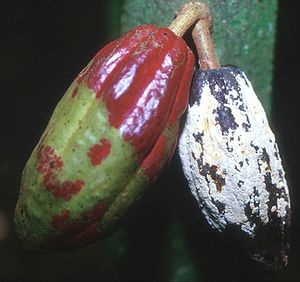
- These football-sized pods have a rough and leathery rind that is approximately 3cm thick .
Roughly 30 to 50 cocoa beans grow in each pod. While most fruits sprout all over a branch, the cocoa pods grow directly from the trunk of the tree or from one of the larger branches. Growing pods are usually green, red, or purple and as they mature, the pods’ colour will change to a yellow or orange (2).
- Harvesting is easily done by hand by farmers because the pods grow close to the trunk of the tree.
Harvesters use short, hooked blades to cut the pods free from the tree. This method prevents damage that may be caused by heavy farming machinery (2). Only pods containing a yellow or orange colour will be harvested; this means harvesting usually occurs 3 to 4 times a week as not all pods will mature simultaneously.
- After collecting all of the ripened pods, they are split open in order to remove the sought after cocoa beans (2).
Prior to drying, the beans are soft and have a white to pale lavender colour. The beans will be placed in large, shallow, heated trays that may be covered by large banana leaves to go through the fermentation process. If the climate allows, the heat source may be the sun. Workers periodically stir the beans to make sure they are equally fermented (2). This process takes 5 to 8 days. The fermented beans now have changed from a pale white to a brown colour. The beans will then be sun dried within a week by simply spreading them out in one layer. At this point, the beans will be sun-dried, scooped into sacks, then shipped to chocolate manufacturers.
Chocolate Production: Factory Processing
- Although there are slight variations in the manufacturing process of cocoa beans as a result of the different species of trees,
the equipment used by the manufacturers are similar. Once in the factory, the dried beans are released from the sacks and roasted to develop the flavour and colour as well as making the outer shell of the bean brittle. Roasting cocoa beans is no simple task. It requires the roast operator to have a keen sense of taste and smell to have the perfect roast.
- The second step at the factory is winnowing.
Winnowing is when the outer shell is removed and the inner part of the cocoa bean is broken down into small pieces called cocoa nibs. These nibs go through a series of sieves that sort them according to size and are then carried along a vibrating conveyor belt. ((11))
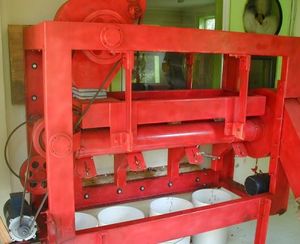
- The third step is to convert the dry cocoa nibs into thick liquid called cocoa liquor by feeding the nibs between two large granite rollers move against a revolving granite slab.
Cocoa liquor is also known as unsweetened chocolate or cocoa mass which contain over 50% fat. The high fat content and the heat generated by the grinding is what change the cocoa from a solid dry form to a liquid paste. At this point, the cocoa liquid has two choices: it can either become cocoa butter by applying pressure to the liquid to obtain the cocoa butter, which is fat, or it can be mixed and re-ground with sugar to make chocolate. There are three basic types of chocolate flavours and depending on the type, different ratios of sugar, milk, and cocoa butter are blended. The more cocoa solids that are in the chocolate, the darker and more bitter it will be (2).
- The next step is refining and conching the chocolate.
Conching is a lengthy process that functions to remove water out of the chocolate by evaporation and blending to assure even coating of every solid particle with cocoa butter as well as decreasing particle size to give the final product a velvet-like texture. It involves agitating, aerating, heating and mixing the liquid chocolate.
Chocolate Production: Tempering
- After conching, the liquid chocolate is tempered.
Tempering is the controlled crystallization of cocoa butter to produce the most stable finished product possible (5). It is a necessary step because chocolate has the ability to crystallize into six different crystal configurations. Most of these configurations are unstable, give an unappealing surface appearance as well as reduce shelf life (5). The six forms differ in the way the glyceride molecules are arranged within fat crystals; this in turn affects not only stability, but also melting point and volume of the solid product. As we move from one form to the next, they become increasingly stable, have higher melting points, and a lower volume (because the crystal structure is more compact).
- Due to the instability of the first three forms, they quickly morph into the next higher level.
Form I is the least stable form and is the result of rapid cooling. It has a low melting point of 17⁰C. It quickly changes into Form II then to Form III and then Form IV. Form IV is common if chocolate does not undergo tempering, or undergoes inadequate tempering. With proper tempering techniques, Form IV will morph into Form V which is the most desirable for high quality chocolate (5). Although Form V is stable, after lengthy storage periods, it can transition back into Form IV that can be recognized by fat bloom on the product.
- Tempering starts off by completely melting the chocolate often at about 50⁰C into a liquid state.
The liquid chocolate is cooled to a temperature where crystallization can occur (5). At this point, both stable and unstable crystal configurations will be created; in other words, Forms I-V will be present sporadically in the mixture. Now, the chocolate is reheated only enough so that the unstable crystals of Forms I-IV will melt because the less stable configurations have lower melting points (5). This creates a mixture with a high concentration of Form V crystals. The temperature needed at this step is dependent on the recipe used and the desired end product (5). For example, it has been found that tempering dark chocolate requires a couple degrees higher than milk chocolate. In these factories, tempering is done by machines that carry the chocolate through the various temperature stages automatically (4). Traditionally, tempering was done by heating the chocolate in a pot, pour it onto a cold metal slab, and work it with a flexible spatula until it cooled and crystallized. The chocolate was then poured into a warm pot to melt away the unstable crystals before the moulding process (5). Chocolatiers that produce small quantities of high quality chocolate still prefer this method.
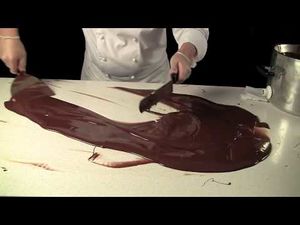
- The degree of temper can be measured using the ‘cooling curve’ of the product (4).
A device has been designed specifically to determine this. It consists of a metal tube connected to a cup at the top where a chocolate sample is placed. A cap then fits snugly over the cup, with a thermometer probe that attached to the centre that protrudes into the chocolate sample. The long metal tube is placed in a flask with water and ice, which will cool the chocolate. As it cools, the device records the changes in temperature to create a graph, or cooling curve, of the tempered chocolate (4). The shape of the curve will tell the manufacturer if the chocolate has been tempered adequately. Properly tempered chocolate will have a ‘Z’ shaped cooling curve (4).
- After the chocolate has been tempered to perfection,it is then poured into molds which allow the chocolate to cool and harden rapidly.
Afterwards, the chocolate can be taken out of the molds, wrapped, and packaged ready for distribution (2).
Finishing Thoughts
- Many cultures and people enjoy chocolate of different sorts, whether it is dark, milk, or even white.
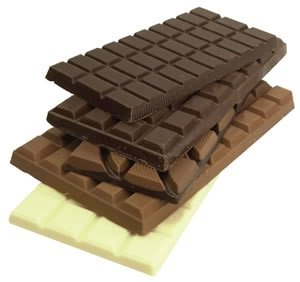
In addition to its sweet taste and velvety texture, chocolate consists of health benefits, however, these health benefits differs between each type of chocolate.
- White chocolate is the least healthy of the three due to the reason that it does not contain any cocoa solids.
It is made from cocoa butter, the fat extracted from the cocoa liquid during the refining process, sugar, milk, an emulsifier such as lecithin, and vanilla, then added back in different amounts during manufacturing (6). The lack of cocoa solids is what gives this chocolate its white colour. Some countries do not consider this chocolate due to the fact it contains no cocoa solids. Since many of the flavonoids and health benefits of chocolate are obtained from the cocoa nibs, white chocolate has the least amount of benefits associated with chocolate (6).
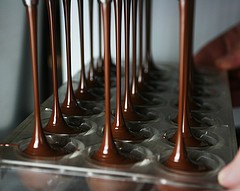
- Milk chocolate contains 10% to 20% cocoa solids as well as a large amount of sugar and milk or cream.
This increases the sugar and fat values and masks the high nutritional value of raw cocoa nibs. In comparison, it has higher nutritional value than white chocolate (6).
- Dark chocolate contains the greatest nutritional value among the three types of chocolate.
This is due to its high content of cocoa solids and low content of sugar and milk. To be classified as a dark chocolate, the product cannot contain more than 12% milk solids and must have at least 35% cocoa solids. Dark chocolate can also be divided to four classes depending on the amount of cocoa solids present: sweet (35-45%), semi-sweet (40-62%), bittersweet (60-85%), and unsweetened (close to 100%)(10).
- The health benefits associated with cocoa is at its highest with dark chocolate (6);
dark chocolate is stated to contain a substantial amount of antioxidants and nutrients such as: calcium, copper, magnesium, phosphorus, potassium, sodium and zinc (8). These are found in greater quantities in cocoa solids than cocoa butter (8). As a result, studies show that dark chocolate may reduce risk of cancer, coughing, and supports cardiovascular health by lowering blood pressure and in turn reducing heart disease. Researchers also state that cocoa solids improve vascular function, energy metabolism, and have anti-inflammatory and antiplatelet effects (7). Other regulations and specifications of chocolate can be found in Division 4 of the Canadian Food and Drug Regulations (9).

- From the bean to the factory, the handling of the cocoa beans and the varying amounts of cocoa butter, sugar and milk added to the cocoa determines the final product as well as its health benefits.
Despite being raised in different cultures, it is a food that is enjoyed on a regular basis by everyone.
Fun Chocolate Tid-Bits
If you are interested in trying Xocolatl, the drink enjoyed by people thousands of years ago, take a look at this recipe found Here
Works Cited
- (1)http://www.smithsonianmag.com/arts-culture/a-brief-history-of-chocolate-21860917/?no-ist
- (2) http://www.sfu.ca/geog351fall03/groups-webpages/gp8/history/history.html
- (3)http://www.humantouchofchemistry.com/coenraad-johannes-van-houten-discovery-of-cocoa-powder.htm
- (4) http://site.ebrary.com/lib/ubc/docDetail.action?docID=10621160
- (5)http://download.springer.com.ezproxy.library.ubc.ca/static/pdf/552/bok%253A978-1-4615-2111-2.pdf?auth66=1396299654_2c1899e73fbd1bc72246ade013568ebe&ext=.pdf
- (6)http://www.fitday.com/fitness-articles/nutrition/calories/dark-chocolate-vs-milk-chocolate-vs-white-chocolate.html#b
- (7) http://en.wikipedia.org/wiki/Health_effects_of_chocolate
- (8) http://en.wikipedia.org/wiki/Cocoa_solids
- (9)http://laws-lois.justice.gc.ca/eng/regulations/C.R.C.,_c._870/page-67.html#h-65
- (10) http://www.cacaoweb.net/chocolate.html
- (11)http://www.grenadachocolate.com/index.html
Exam Question
- What means of preparation have been developed for cassava and why?
- Answer: The cassava is soaked in water before cooking cause it hydrolosizes the glycosides and destroys the b-glucosidase present.